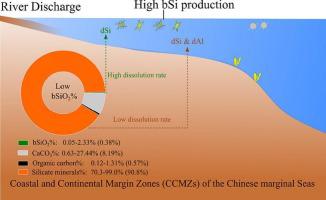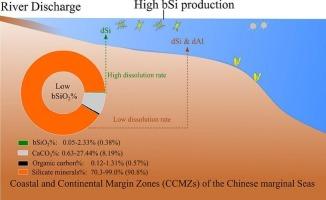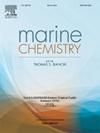Muddy sediments are an important potential source of silicon in coastal and continental margin zones
Abstract
The dissolution of silicate minerals on the seafloor releases an important amount of dissolved silicon (dSi), which is necessary for maintaining high diatom production in Coastal and Continental Margin Zones (CCMZs). However, the dissolution of silicate minerals along the continental shelves is variable, which hinders our understanding of the marine Si cycle on both a regional and global scale. To understand the discrepancy of silicon (Si) released in different sediment matrices and its potential controlling factors, we investigated surface sediments of typical CCMZs of the Chinese marginal Seas using a continuous alkaline extraction technique, grain size and chemical (carbon and total nitrogen) analysis as well as a qualitative measurement of clay mineral composition by X-ray diffraction. The results showed that the amount of Si and aluminum (Al) leached from muddy sediments were 2 times greater than those released from sandy sediments. High dissolution rates (> 0.20 mg-SiO2 g−1 min−1) of silicate minerals are caused by a large sediment-specific surface area. Further, our data showed that biogenic silica (bSi) with high Al content (Si:Al < 40) has low reactivity and that the source of Al incorporated in bSi is silicate minerals undergoing dissolution. We show that although the dissolution of silicate minerals is less active than that of bSi, it still potentially releases more bio-available Si and Al to seawater due to its dominant presence on the seafloor (70.3% − 99.0%wt). This study highlights silicate minerals as an important potential marine Si source and emphasizes the need for a better understanding of the roles of silicate minerals in the Si cycle of marginal seas in future studies.



 求助内容:
求助内容: 应助结果提醒方式:
应助结果提醒方式:


